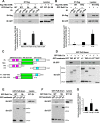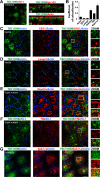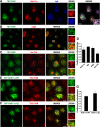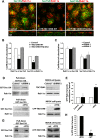TBC1D9B functions as a GTPase-activating protein for Rab11a in polarized MDCK cells
- PMID: 25232007
- PMCID: PMC4230784
- DOI: 10.1091/mbc.E13-10-0604
TBC1D9B functions as a GTPase-activating protein for Rab11a in polarized MDCK cells
Abstract
Rab11a is a key modulator of vesicular trafficking processes, but there is limited information about the guanine nucleotide-exchange factors and GTPase-activating proteins (GAPs) that regulate its GTP-GDP cycle. We observed that in the presence of Mg(2+) (2.5 mM), TBC1D9B interacted via its Tre2-Bub2-Cdc16 (TBC) domain with Rab11a, Rab11b, and Rab4a in a nucleotide-dependent manner. However, only Rab11a was a substrate for TBC1D9B-stimulated GTP hydrolysis. At limiting Mg(2+) concentrations (<0.5 mM), Rab8a was an additional substrate for this GAP. In polarized Madin-Darby canine kidney cells, endogenous TBC1D9B colocalized with Rab11a-positive recycling endosomes but less so with EEA1-positive early endosomes, transferrin-positive recycling endosomes, or late endosomes. Overexpression of TBC1D9B, but not an inactive mutant, decreased the rate of basolateral-to-apical IgA transcytosis--a Rab11a-dependent pathway--and shRNA-mediated depletion of TBC1D9B increased the rate of this process. In contrast, TBC1D9B had no effect on two Rab11a-independent pathways--basolateral recycling of the transferrin receptor or degradation of the epidermal growth factor receptor. Finally, expression of TBC1D9B decreased the amount of active Rab11a in the cell and concomitantly disrupted the interaction between Rab11a and its effector, Sec15A. We conclude that TBC1D9B is a Rab11a GAP that regulates basolateral-to-apical transcytosis in polarized MDCK cells.
© 2014 Gallo et al. This article is distributed by The American Society for Cell Biology under license from the author(s). Two months after publication it is available to the public under an Attribution–Noncommercial–Share Alike 3.0 Unported Creative Commons License (http://creativecommons.org/licenses/by-nc-sa/3.0).
Figures









Similar articles
-
The LMTK1-TBC1D9B-Rab11A Cascade Regulates Dendritic Spine Formation via Endosome Trafficking.J Neurosci. 2019 Nov 27;39(48):9491-9502. doi: 10.1523/JNEUROSCI.3209-18.2019. Epub 2019 Oct 18. J Neurosci. 2019. PMID: 31628178 Free PMC article.
-
Regulation of vesicle trafficking in madin-darby canine kidney cells by Rab11a and Rab25.J Biol Chem. 2000 Sep 15;275(37):29138-46. doi: 10.1074/jbc.M004410200. J Biol Chem. 2000. PMID: 10869360
-
Association of Rab25 and Rab11a with the apical recycling system of polarized Madin-Darby canine kidney cells.Mol Biol Cell. 1999 Jan;10(1):47-61. doi: 10.1091/mbc.10.1.47. Mol Biol Cell. 1999. PMID: 9880326 Free PMC article.
-
Exocyst requirement for endocytic traffic directed toward the apical and basolateral poles of polarized MDCK cells.Mol Biol Cell. 2007 Oct;18(10):3978-92. doi: 10.1091/mbc.e07-02-0097. Epub 2007 Aug 8. Mol Biol Cell. 2007. PMID: 17686995 Free PMC article.
-
Multiple functions and dual characteristics of RAB11A in cancers.Biochim Biophys Acta Rev Cancer. 2023 Nov;1878(6):188966. doi: 10.1016/j.bbcan.2023.188966. Epub 2023 Aug 30. Biochim Biophys Acta Rev Cancer. 2023. PMID: 37657681 Review.
Cited by
-
LMTK1, a Novel Modulator of Endosomal Trafficking in Neurons.Front Mol Neurosci. 2020 Jun 30;13:112. doi: 10.3389/fnmol.2020.00112. eCollection 2020. Front Mol Neurosci. 2020. PMID: 32714146 Free PMC article.
-
TBC1D8B Loss-of-Function Mutations Lead to X-Linked Nephrotic Syndrome via Defective Trafficking Pathways.Am J Hum Genet. 2019 Feb 7;104(2):348-355. doi: 10.1016/j.ajhg.2018.12.016. Epub 2019 Jan 17. Am J Hum Genet. 2019. PMID: 30661770 Free PMC article.
-
Rab11-FIP1 and Rab11-FIP5 Regulate pIgR/pIgA Transcytosis through TRIM21-Mediated Polyubiquitination.Int J Mol Sci. 2021 Sep 28;22(19):10466. doi: 10.3390/ijms221910466. Int J Mol Sci. 2021. PMID: 34638806 Free PMC article.
-
Recycling Endosomes and Viral Infection.Viruses. 2016 Mar 8;8(3):64. doi: 10.3390/v8030064. Viruses. 2016. PMID: 27005655 Free PMC article. Review.
-
The integration of autophagy and cellular trafficking pathways via RAB GAPs.Autophagy. 2015;11(12):2393-7. doi: 10.1080/15548627.2015.1110668. Autophagy. 2015. PMID: 26565612 Free PMC article. Review.
References
-
- Adari H, Lowy DR, Willumsen BM, Der CJ, McCormick F. Guanosine triphosphatase activating protein (GAP) interacts with the p21 ras effector binding domain. Science. 1988;240:518–521. - PubMed
-
- Azouz NP, Matsui T, Fukuda M, Sagi-Eisenberg R. Decoding the regulation of mast cell exocytosis by networks of Rab GTPases. J Immunol. 2012;189:2169–2180. - PubMed
-
- Bacallao R, Stelzer EH. Preservation of biological specimens for observation in a confocal fluorescence microscope and operational principles of confocal fluorescence microscopy. Methods Cell Biol. 1989;31:437–452. - PubMed
Publication types
MeSH terms
Substances
Grants and funding
LinkOut - more resources
Full Text Sources
Other Literature Sources
Research Materials
Miscellaneous

